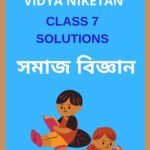SEBA Class 7 Social Science MCQ Chapter 6 Man – Made Environment and the Human Resources Solutions in English Medium, Class 7 Social Science Multiple Choice Question Answer in English to each chapter is provided in the list so that you can easily browse throughout different chapters SEBA Class 7 Social Science MCQ Chapter 6 Man – Made Environment and the Human Resources Notes and select need one.
SEBA Class 7 Social Science MCQ Chapter 6 Man – Made Environment and the Human Resources
Also, you can read the SCERT book online in these sections Class 7 Social Science Objective Type Solutions by Expert Teachers as per SCERT (CBSE) Book guidelines. These solutions are part of SCERT All Subject Solutions. Here we have given Assam SEBA Class 7 Social Science Multiple Choice Notes for All Subject, You can practice these here.
Man – Made Environment and the Human Resources
Chapter – 6
GEOGRAPHY
| MCQ |
1. What is the term used to describe the natural world, including the air, water, land, and living organisms?
(A) Ecology.
(B) Environment.
C) Ecosystem.
(D) Biodiversity.
Answer: (B) Environment.
2. Which component of the environment includes mountains, rivers, and forests?
(A) Abiotic.
(B) Biotic.
(C) Hydrosphere
(D) Lithosphere.
Answer: (D) Lithosphere.
3. What is the interaction of living organisms with their physical environment called?
(A) Ecosystem.
(B) Habitat.
(C) Ecology.
(D) Biodiversity.
Answer: (A) Ecosystem.
4. Which sphere of the Earth is composed of water bodies like oceans, rivers, and lakes?
(A) Atmosphere.
(B) Lithosphere.
(C) Hydrosphere.
(D) Biosphere.
Answer: (C) Hydrosphere.
5. Which layer of the Earth contains all the air in our
environment?
(A) Lithosphere.
(B) Atmosphere.
(C) Hydrosphere.
(D) Biosphere.
Answer: (B) Atmosphere.
6. What is the narrow zone where land, water, and air interact and support life called?
(A) Ecosystem.
(B) Biosphere.
(C) Habitat.
(D) Environment.
Answer: (B) Biosphere.
7. Which of the following is NOT a natural component of the environment?
(A) Air.
(B) Water.
(C) Buildings.
(D) Soil.
Answer: (C) Buildings.
8. The variety of living organisms on Earth is known as?
(A) Ecology.
(B) Ecosystem.
(C) Biodiversity.
(D) Habitat.
Answer: (C) Biodiversity.
9. What is the term for a place where a particular population of species lives?
(A) Ecosystem.
(B) Habitat.
(C) Biosphere.
(D) Community.
Answer: (B) Habitat.
10. Which human activity is a major cause of environmental pollution?
(A) Planting trees.
(B) Industrialization.
(C) Wildlife conservation.
(D) Organic farming.
Answer: (B) Industrialization.
11. Which type of pollution is caused by harmful substances in the air?
(A) Water pollution.
(B) Soil pollution.
(C) Air pollution.
(D) Noise pollution.
Answer: (C) Air pollution.
12. What is the primary cause of water pollution?
(A) Excessive rainfall.
(B) Dumping of waste materials.
(C) Soil erosion.
(D) Wildlife activities.
Answer: (B) Dumping of waste materials.
13. Which substance is NOT considered a pollutant?
(A) Carbon monoxide.
(B) Oxygen.
(C) Sulphur dioxide.
(D) Lead.
Answer: B) Oxygen.
14. What term describes the contamination of the natural environment that causes adverse changes?
(A) Conservation.
(B) Pollution.
(C) Recycling.
(D) Preservation.
Answer: B) Pollution.
15. Which renewable resource is commonly used to generate electricity?
(A) Coal.
(B) Natural gas.
(C) Solar energy.
(D) Petroleum.
Answer: (C) Solar energy.

Hi! my Name is Parimal Roy. I have completed my Bachelor’s degree in Philosophy (B.A.) from Silapathar General College. Currently, I am working as an HR Manager at Dev Library. It is a website that provides study materials for students from Class 3 to 12, including SCERT and NCERT notes. It also offers resources for BA, B.Com, B.Sc, and Computer Science, along with postgraduate notes. Besides study materials, the website has novels, eBooks, health and finance articles, biographies, quotes, and more.




